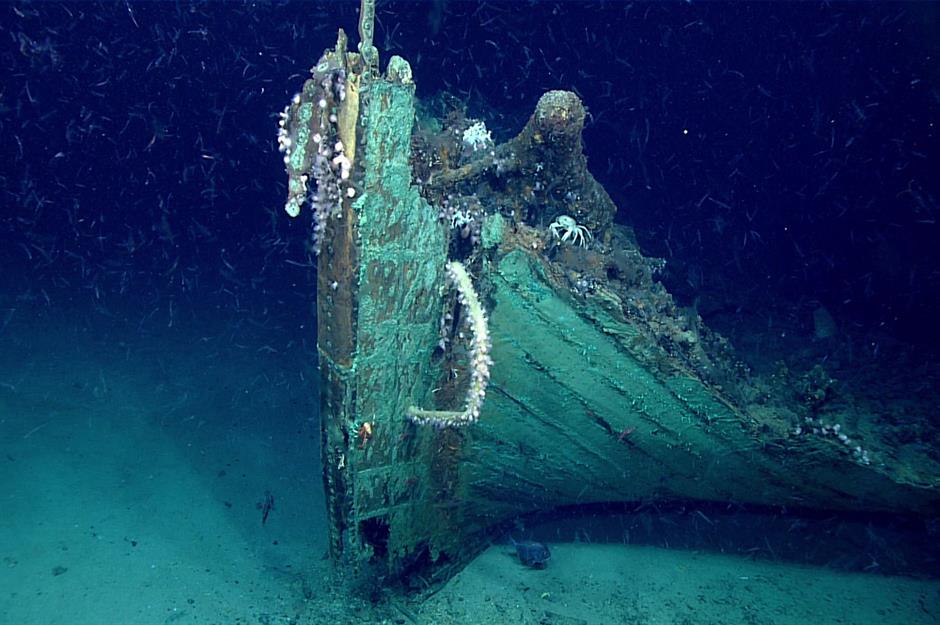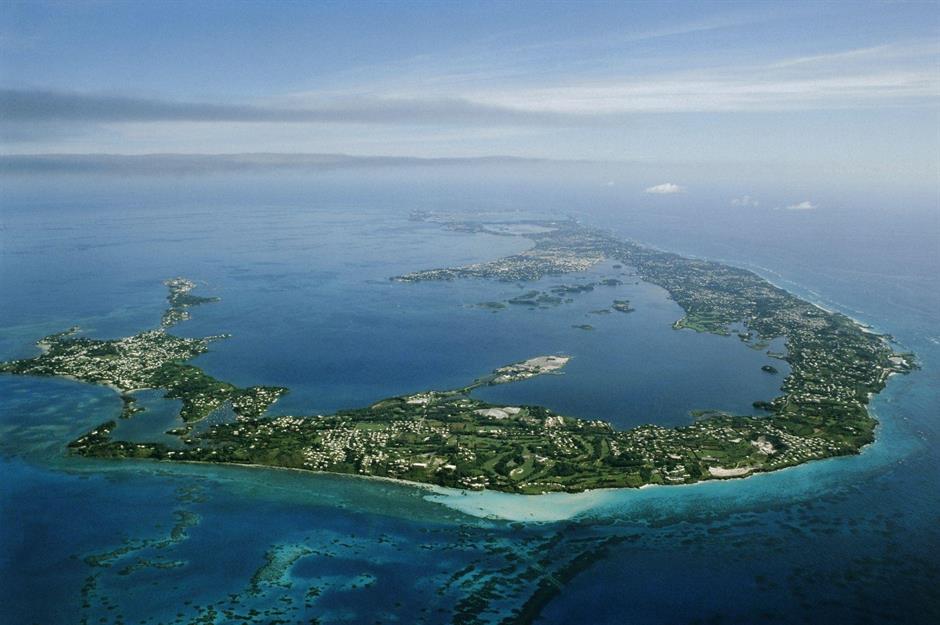11 ocean mysteries even experts can't explain
The ocean is a mighty beast
The Earth's mighty oceans are even more mysterious than outer space. The majority of the planet's surface is covered by water, but 95% of our oceans remain unexplored. We know more about Mars than we do the deep, dark sea – and with that comes many unsolved and downright baffling puzzles.
From cursed shipwrecks to creepy deep-sea noises, let’s dive into ocean mysteries that even experts can't explain…
Bermuda Triangle, North Atlantic Ocean
Covering around 500,000 square miles (around 1.3m sqkm) between Bermuda, Miami in Florida and San Juan in Puerto Rico, the Bermuda Triangle is one of the ocean’s most notorious mysteries. Hundreds of planes and ships have crashed in the area without explanation – with some vanishing completely. In March 1918, the USS Cyclops (one of the US Navy's biggest ships) disappeared between Barbados and Baltimore, Maryland, with over 300 people on board. The wreck has never been discovered, and no reason for its disappearance has been found either.
Bermuda Triangle, North Atlantic Ocean
Yet the Bermuda Triangle isn’t recognised as a particularly hazardous place; even the US Coastguard has previously said that no extraordinary factors have ever been identified. Theories range from supernatural activity to electromagnetic interference causing compass problems, though plenty continue to navigate this busy shipping route without trouble...
Love this? Follow us on Facebook for more travel inspiration
Mariana Trench, Pacific Ocean
Mariana Trench, Pacific Ocean
Cold Water Mirage, various
Cold Water Mirage, various
Some reckon that a Cold Water Mirage explains the Titanic’s fate, as the ship had sailed into the cold Labrador Current which clashed with warm Gulfstream waters. With these right weather conditions in place, a false horizon could have altered the view of the iceberg, with devastating consequences. Cold Water Mirages often occur in Antarctica, the Great Lakes and the Canadian and Californian coasts.
Baltic Sea anomaly, Gulf of Bothnia
Baltic Sea anomaly, Gulf of Bothnia
Some believe it’s debris from the Second World War or Cold War, or an Ice Age deposit or something created by an ancient civilisation. Others reckon it’s an alien spacecraft. And, weirdly, electric equipment that gets too close to it is said to malfunction. Just what could it be – and how did it get there?
1968 disappearances: INS Dakar, Mediterranean Sea
In 1968, four submarines from three different countries vanished. In January 1968, the Israeli naval ship INS Dakar was returning from Scotland to Israel. It sent a message from the east of Crete, but this would be its final message, as the ship never arrived. In 1991 the shipwreck was finally discovered 9,800 feet (almost 3,000m) underwater, between Crete and Cyprus. Experts believe the INS Dakar experienced a mechanical or human error, or flooding, causing it to sink. Sections of the salvaged ship (pictured) are now on display at the Naval Museum in Haifa, Israel.
1968 disappearances: La Minerve, French Coast
The French navy submarine La Minerve also vanished in January 1968 during a military exercise with 52 crew on board. Alarms were raised when it failed to return to its base in Toulon, France the next day. Then, in 2019, underwater drones managed to locate the shipwreck some 27 miles (45km) off the French coast. The sub had broken into pieces – its vessel name still visible – resting in a seabed with low sedimentation, leaving it well-preserved. However, it’s still not known exactly what caused the sub to sink in just four minutes – but some think it could have been rudder problems.
1968 disappearances: K-129, Pacific Ocean
In March 1968, the K-129 left its base in Petropavlovsk, eastern Russia, for a routine patrol. The Soviet submarine was supplied with three nuclear missiles and had 83 crew on board when a huge underwater explosion was detected. An initial recovery mission was unsuccessful, but in August 1968 the US managed to locate it 1,500 miles (2,414km) northwest of Hawaii at 16,500 feet (5,000m) beneath the surface. The CIA kept its retrieval in 1974 top secret, while the Soviets suspected American foul play. Will we ever know the full story?
1968 disappearances: USS Scorpion, Mediterranean Sea
That same year in May, the US nuclear submarine USS Scorpion was on its way back to base from the Mediterranean when it disappeared. Then in October 1968, the shattered hull was eventually located; pictured here is part of the wreckage. Mysteriously, nothing official has ever been announced, leading some theorists to suggest that the sub was a target of a Soviet attack.
Shipwrecks, Gulf of Mexico
Shipwrecks, Gulf of Mexico
There’s still much to learn about the ship – including its country of origin, the number of crew on board, its purpose and how it sank. All experts have to go on is the number 2109, which is nailed along the edge of the ship’s rudder, as well as metal artefacts found nearby. Seeing as only the hull is well preserved, it’s been suggested that the vessel may have caught fire before sinking.
Devil’s Sea, Pacific Ocean
Off the south coast of Japan lies the Devil’s Sea (or Manoumi), a deadly stretch of water steeped in myth and legend. For centuries, countless lives, ships, submarines and planes have been lost here. The treacherous area extends between Japan, the Bonin Islands and a large section of the Philippine Sea, and is nicknamed the ‘Bermuda Triangle of the Pacific’.
Now discover the world's greatest mysteries that may never be solved
Devil’s Sea, Pacific Ocean
It's thought that the terror of the Devil's Sea could be down to Mother Nature. This is an area where the pull of electromagnetic waves is particularly strong, known as a Vile Vortice. In 1952, a Japanese research ship was sent to the area to investigate previous shipwrecks, before going missing itself. Following this final tragedy, the Japanese government declared the Devil’s Sea too dangerous for voyages, and, eerily, all efforts to establish facts about the area have been abandoned ever since.
SS Waratah, Indian Ocean
In one of the biggest nautical mysteries of all time, the SS Waratah has been lost for over a century. In July 1909, the passenger steamship set sail from Durban to Cape Town before vanishing somewhere off the eastern coast of South Africa. The 500 foot-long (152m) liner weighed almost 10,000 tonnes and was carrying 211 people on board. Still to this day, no evidence of the ship has been found.
SS Waratah, Indian Ocean
Twilight Zone
Twilight Zone
Upsweep sound, Pacific Ocean
Upsweep sound
The Upsweep is usually recorded near areas of undersea volcanic activity, but experts still can’t locate its origin. Underwater volcanoes are common – in August 2023 three were discovered off the coast of Sicily – and it’s likely there are thousands more yet to be discovered (only 20% of the ocean floor has been mapped by ships).
Yonaguni Monument, Japan
The origin of the Yonaguni Monument, an underwater rock structure that was discovered in the mid 1980s near Yonaguni Island in Japan, continues to baffle experts. Some think it is a man-made stepped pyramid, especially as certain rocks appear to have carvings on them. There are also other formations nearby which have led some to believe it could be part of an ancient submerged city, at least 5, 000 years old, and belong to a lost civilisation – possibly the legendary Mu or Lemuria.
Yonaguni Monument, Japan
However other researchers think that the monument is a natural formation, shaped over the centuries by underwater currents. Those in this camp believe that the symmetry of the rocks is not as pronounced as some have said, and that the structure is made out of solid rocks rather than the distinct blocks which would be proof of human involvement. They also argue that the 'carvings' are actually naturally occurring scratches.

